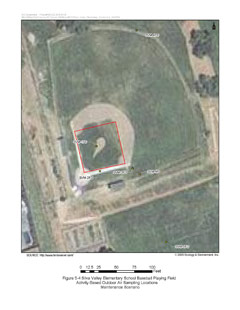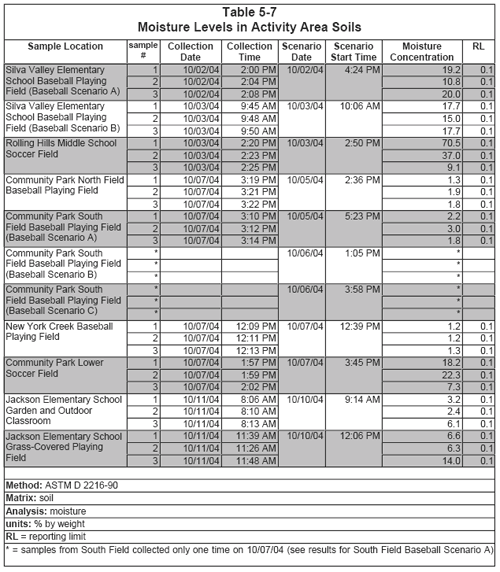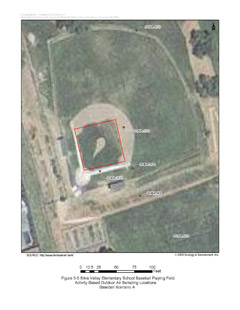Pacific Southwest, Region 9
Serving: Arizona, California, Hawaii, Nevada, Pacific Islands, Tribal Nations
Naturally Occurring Asbestos
El Dorado Hills
Multimedia Exposure Assessment
Preliminary Assessment and Site Inspection Report Interim Final
5.0 Summary of Investigative Efforts (cont'd)
5.4 Air Sampling
5.4.2.1 Silva Valley Elementary School
Field Maintenance Scenario. The baseball playing field at Silva Valley Elementary School is ordinarily maintained by parent volunteers during the playing season. The school district closed the field to Little League play during 2004. The field was mowed routinely, but grass had been allowed to grow over the basepaths and pitcher’s mound areas. To conduct the baseball scenarios, the pitcher’s mound and basepaths had to be cleared to bare soil, so the START added a new “field maintenance” scenario to the schedule. In doing so, the START was able to collect samples representing activities of parent volunteers while restoring the field to a condition suitable for conducting baseball play scenarios.
The START conducted the field maintenance scenario on October 2, 2004. The field maintenance scenario was conducted with six members of the sampling team simulating adult/parent volunteers who used rakes, hoes, and other garden tools to clear the basepaths and the pitcher’s mound area. Sampling team members removed the grass and weeds from the areas cleared, shaking loose the dirt from the roots as needed, then placed the material that was removed in plastic garbage bags, which were later taken to the local dump in accordance with appropriate disposal procedures.
During the field maintenance scenario each member of the sampling team wore a personal air monitoring pump whose intake was set at a height of about 5 feet above ground surface to approximate the breathing height of parent volunteers. The intakes were also set at a height of about 5 feet for the air collection filter cassettes of the stationary sample pumps for the field maintenance scenario.
The outline of the field and the positions of the stationary air sample pumps operating during the field maintenance scenario are shown as SVM-1FD, SVM-2FD, SVM-3FD, SVM-4FD, and SVM-5FD on Figure 5-4 (Silva Valley Elementary School Baseball Playing Field Activity-Based Outdoor Air Sampling Locations–Maintenance Scenario). The position of the mobile meteorological station is shown as SVM-MS. A summary of results for the field maintenance scenario samples is shown in Table 5-6 (Silva Valley Elementary School Baseball Playing Field Maintenance Scenario Air Sample Summary Results). See Appendix B for a summary of the results from dust monitoring during this scenario.
Baseball Scenario A. The playing field at Silva Valley Elementary School was initially wet when the START arrived, and after clearing the basepaths and pitcher’s mound the soil was still fairly moist. The purpose of the sampling during the baseball scenarios was to simulate baseball play on the field during the dry season, so instead of conducting two more baseball play scenarios immediately after the maintenance scenario, the START revised the planned sampling schedule. The START conducted one baseball play scenario on the field on the afternoon following the maintenance scenario (October 2, 2004), but then waited until the next morning to conduct the second baseball play scenario to allow the soil to dry out somewhat. This change impacted the schedule for scenarios that had been planned for the following day, so one of the three jogging/walking scenarios on the New York Creek Nature Trail was dropped from the schedule.
Prior to conducting the baseball play scenarios at Silva Valley Elementary School, to test the moisture level of the field the START collected three soil samples from dispersed locations on the field just below the top ¼ to ½ inch of soil. The START also collected soil moisture samples similarly from other playing fields and areas where activity-based sampling was conducted throughout the week. Many of these soil moisture samples were collected just prior to conducting activity-based sampling; in a few cases they were collected after activity-based sampling had already been conducted. Table 5-7 (Moisture Levels in Activity Area Soils) shows the results of the soil moisture tests conducted for the Silva Valley Elementary School baseball playing field, as well as for the other playing fields.
Figure 5-4
Silva Valley Elementary School Baseball Playing Field Activity-Based Outdoor Air Sampling
Locations B Maintenance Scenario
(click image for larger version)

|
Table 5-6 Silva Valley Elementary School Baseball Playing Field Maintenance Scenario Air Sample Summary Results |
||||||
| Sample ID | Location | Location Description | Date | PCME Structures (s/cc) | AHERA-like Total Structures (s/cc) | Sensitivity (s/cc) |
| SVM-H2-1FD-100204 | SVM-1FD | pitcher's mound hi-vol | 10/02/04 | 0.000998 | 0.00200 | 0.000998 |
| SVM-H2-2FD-100204 | SVM-2FD | downwind hi-vol | 10/02/04 | 0.00194 | 0.00291 | 0.000968 |
| SVM-H2-3FD-100204 | SVM-3FD | offset downwind hi-vol | 10/02/04 | 0.000994 | 0.000994 | 0.000994 |
| SVM-H2-4FD-100204 | SVM-4FD | upwind hi-vol | 10/02/04 | <0.00289 | <0.00289 | 0.000967 |
| SVM-H2-5FD-100204 | SVM-5FD | far downwind hi-vol | 10/02/04 | 0.00387 | 0.00580 | 0.000967 |
| SVM-L2-1AD-100204 | SVM-1AD | adult #1 | 10/02/04 | <0.00299 | 0.00500 | 0.000999 |
| SVM-L2-2AD-100204 | SVM-2AD | adult #2 | 10/02/04 | 0.00299 | 0.00498 | 0.000995 |
| SVM-L2-3AD-100204 | SVM-3AD | adult #3 | 10/02/04 | 0.00499 | 0.00699 | 0.000998 |
| SVM-L2-4AD-100204 | SVM-4AD | adult #4 | 10/02/04 | 0.000992 | 0.00298 | 0.000992 |
| SVM-L2-5AD-100204 | SVM-5AD | adult #5 | 10/02/04 | 0.00299 | 0.00498 | 0.000997 |
| SVM-L2-15AD-100204 | SVM-5AD | duplicate of adult #5 | 10/02/04 | <0.00300 | 0.00100 | 0.00100 |
| SVM-L2-6AD-100204 | SVM-6AD | adult #6 | 10/02/04 | 0.000991 | 0.00297 | 0.00297 |
| CC1-L6-1CA-100204 | adult #1 | composite sample collected during the 100204 scenarios | 10/02/04 | 0.000992 | 0.00595 | 0.000992 |
| CC1-L6-1CB-100204 | adult/child #1 | composite sample collected during the 100204 scenarios | 10/02/04 | 0.000972 | 0.00389 | 0.000972 |
| CC1-L6-2CB-100204 | adult/child #2 | composite sample collected during the 100204 scenarios | 10/02/04 | 0.00202 | 0.00808 | 0.00101 |
| CC1-L6-3CB-100204 | adult/child #3 | composite sample collected during the 100204 scenarios | 10/02/04 | results pending | results pending | results pending |
|
PCME fibers = fibers longer than 5 microns with a width between 0.25 and 3 microns, and an aspect ratio (length to width) greater than 3:1 AHERA-like total structures = structures longer than 0.5 microns with an aspect ratio greater than 3:1 (Note this differs somewhat from the strict AHERA structure definition) Sensitivity = the sample-specific lowest concentration of asbestos the laboratory can reliably detect s/cc = structures per cubic centimeter |
||||||
The START conducted activity-based outdoor air sampling during this scenario according to the following scripted schedule:
- For the entire 2-hour scenario, one member of the sampling team simulated the activities of an adult/parent spectator walking and standing behind the backstop and sitting in the dugouts. The intake for the air collection filter cassette worn by this sampling team member was set at a height of about 5 feet.
- For the first 30 minutes, five other members of the sampling team used rakes and brooms to perform types of field maintenance activities that might be conducted prior to a game. One team member swept in the dugouts, three used rakes on the dirt areas of the infield, and one observed the maintenance activities at close range to the others who were performing the work. The intakes for the air collection filter cassettes worn by these sampling team members were set at a height of about 3 feet.
- For the remaining 90 minutes, the five other members of the sampling team alternately sat in the dugouts for 10 minutes then played baseball (infield practice) for 20 minutes; this pattern was repeated three times in the 90 minutes.
- During the last 30 minutes of infield practice play, a seventh member of the sampling team who was not wearing a sample pump entered the scenario to run bases and slide toward bases. This member of the sampling team was allowed to engage in more vigorous physical activity than the other members of the sampling team without having to worry about damaging the equipment or having the pumps fall out of the belts.
Table 5-7
(click image for larger version)

The outline of the field and the positions of the stationary air sample pumps operating during the first baseball scenario are shown as SVBA-1FD, SVBA-2FD, SVBA-3FD, SVBA-4FD, and SVBA-5FD on Figure 5-5 (Silva Valley Elementary School Baseball Playing Field Activity-Based Outdoor Air Sampling Locations–Baseball Scenario A). The position of the mobile meteorological station is shown as SVBA-MS. A summary of results for Baseball Scenario A samples is shown in Table 5-8 (Silva Valley Elementary School Baseball Scenario A Air Sample Summary Results). See Appendix B for a summary of the results from dust monitoring during this scenario.
Baseball Scenario B. The START collected soil samples to test the moisture level again immediately prior to conducting the second baseball play scenario at Silva Valley Elementary School (see Table 5-7: Moisture Levels in Activity Area Soils).
The START conducted Baseball Scenario B on October 3, 2004. The START conducted activity-based outdoor air sampling during the second baseball play scenario according to the same scripted schedule that was used for Baseball Scenario A.
The outline of the field and the positions of the stationary air sample pumps operating during the second baseball scenario are shown as SVBB-1FD, SVBB-2FD, SVBB-3FD, SVBB-4FD, and SVBB-5FD on Figure 5-6 (Silva Valley Elementary School Baseball Playing Field Activity-Based Outdoor Air Sampling Locations–Baseball Scenario B). The position of the mobile meteorological station is shown as SVBB-MS. A summary of results for the field maintenance scenario samples is shown in Table 5-9 (Silva Valley Elementary School Baseball Scenario B Air Sample Summary Results). See Appendix B for a summary of the results from dust monitoring during this scenario.
Figure 5-5
Silva Valley Elementary School Baseball Playing Field Activity-Based Outdoor Air Sampling
Locations B Baseball Scenario A
(Click image for larger version)

|
Table 5-8 Silva Valley Elementary School Baseball Scenario A Air Sample Summary Results |
||||||
| Sample ID | Location | Location Description | Date | PCME Structures (s/cc) | AHERA-like Total Structures (s/cc) | Sensitivity (s/cc) |
| SVBA-H2-1FD-100204 | SVBA-1FD | pitcher's mound hi-vol | 10/02/04 | 0.000994 | 0.0169 | 0.000994 |
| SVBA-H2-2FD-100204 | SVBA-2FD | downwind hi-vol | 10/02/04 | 0.00300 | 0.00900 | 0.00100 |
| SVBA-H2-3FD-100204 | SVBA-3FD | offset downwind hi-vol | 10/02/04 | <0.00294 | 0.00295 | 0.000984 |
| SVBA-H2-4FD-100204 | SVBA-4FD | upwind hi-vol | 10/02/04 | 0.000967 | 0.00193 | 0.000967 |
| SVBA-H2-5FD-100204 | SVBA-5FD | far downwind hi-vol | 10/02/04 | 0.000964 | 0.00289 | 0.000964 |
| SVBA-L2-1CH-100204 | SVBA-1CH | child #1 | 10/02/04 | 0.0101 | 0.0202 | 0.00101 |
| SVBA-L2-11CH-100204 | SVBA-1CH | duplicate of child #1 | 10/02/04 | 0.00498 | 0.0189 | 0.000997 |
| SVBA-L2-2CH-100204 | SVBA-2CH | child #2 | 10/02/04 | <0.00296 | 0.0139 | 0.000992 |
| SVBA-L2-3CH-100204 | SVBA-3CH | child #3 | 10/02/04 | 0.00199 | 0.00897 | 0.000997 |
| SVBA-L2-4CH-100204 | SVBA-4CH | child #4 | 10/02/04 | 0.00697 | 0.0110 | 0.000996 |
| SVBA-L2-5CH-100204 | SVBA-5CH | child #5 | 10/02/04 | 0.00393 | 0.0137 | 0.000981 |
| SVBA-L2-1NA-100204 | SVBA-1NA | non-active adult | 10/02/04 | <0.00298 | <0.00298 | 0.000995 |
| CC1-L6-1CA-100204 | adult #1 | composite sample collected during the 100204 scenarios | 10/02/04 | 0.000992 | 0.00595 | 0.000992 |
| CC1-L6-1CB-100204 | adult/child #1 | composite sample collected during the 100204 scenarios | 10/02/04 | 0.000972 | 0.00389 | 0.000972 |
| CC1-L6-2CB-100204 | adult/child #2 | composite sample collected during the 100204 scenarios | 10/02/04 | 0.00202 | 0.00808 | 0.00101 |
| CC1-L6-3CB-100204 | adult/child #3 | composite sample collected during the 100204 scenarios | 10/02/04 | results pending | results pending | results pending |
| SVBA-L2-1ZB-100204 | field blank | field blank | 10/02/04 | <0.00296 | <0.00296 | 0.000991 |
|
PCME fibers = fibers longer than 5 microns with a width between 0.25 and 3 microns, and an aspect ratio (length to width) greater than 3:1 AHERA-like total structures = structures longer than 0.5 microns with an aspect ratio greater than 3:1 (Note this differs somewhat from the strict AHERA structure definition) Sensitivity = the sample-specific lowest concentration of asbestos the laboratory can reliably detect s/cc = structures per cubic centimeter |
||||||
| Region 9 NewsroomRegion 9 Programs | Grants & FundingUS-Mexico Border | Media CenterCareers | About Region 9A-Z Index |
